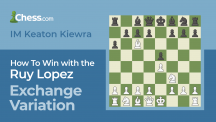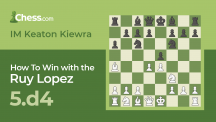Ruy López Opening
The Ruy Lopez (also known as the Spanish Opening or Spanish Game) is one of the oldest and most analyzed openings in chess history. Most of the world's top players have adopted this rich opening as part of their repertoire, and many of them play it with both colors. Despite having a large amount of theory, it is an opening that players of all levels can enjoy.
- Starting Position
- Variations
- How To Play Against The Ruy Lopez
- History Of The Ruy Lopez
- Famous Games
- Conclusion
Starting Position
The Ruy Lopez starts after the moves 1.e4 e5 2.Nf3 Nc6 3.Bb5. White finishes the development of their kingside pieces and gets ready to castle short. The critical idea behind 3.Bb5, however, is to attack Black's c6-knight. White fights for the control of the central d4 and e5-squares and indirectly threatens the black e5-pawn by attacking its only defender.

Although the Ruy Lopez is a flexible opening that can lead to tactical skirmishes, games usually develop into a long struggle for the center that spreads to an attack on the flanks. Since Black has a hard time getting an advantage in this opening, some people refer to it as the "Spanish Torture."
Pros
- It leads to very complex and multifaceted play
- It tends to give White long-term pressure
- White develops rapidly, and castles quickly
- There are good lines for both tactical and positional players
Cons
- It's difficult to learn its extensive theory
- Black has a vast number of defenses to choose from
Variations
The Ruy Lopez is one of the most studied openings in chess. With all its most popular moves deeply analyzed by generations of elite players, the theory behind the Spanish Game grew to enormous proportions. Below you can find a list of some of the prevalent lines of the opening:
Main Line
The Main Line of the Ruy Lopez sees White positioning their pieces to prepare for a long struggle for central control. Black starts to fend off the white light-squared bishop with 3...a6. After White castles, the game can still take many different directions.
1.e4 e5 2.Nf3 Nc6 3.Bb5 a6 4.Ba4 Nf6 5.O-O
Closed Variation
In the Closed Variation, Black puts their dark-squared bishop on e7, usually inside the pawn chain. After Black's fifth move, play can continue in many different ways.
1. e4 e5 2. Nf3 Nc6 3. Bb5 a6 4. Ba4 Nf6 5. O-O Be7
Berlin Defense
The Berlin Defense is one of Black's most solid responses to the Ruy Lopez. Players usually go for an early queen exchange. Black accepts doubled pawns on the c-file and forfeits castling rights for the bishop pair and a solid position.
1. e4 e5 2. Nf3 Nc6 3. Bb5 Nf6
Exchange Variation
In the Exchange Variation, White captures the black knight on c6 to double Black's pawns. If White plays d2-d4, a favorable endgame with a pawn majority on the kingside can occur. Black gets the bishop pair as compensation and can equalize with accurate play, whether White goes for d2-d4 or a quieter system with d2-d3. This line avoids the need to memorize a lot of theory.
1.e4 e5 2.Nf3 Nc6 3.Bb5 a6 4.Bxc6
Open Variation
With the Open Variation, Black takes the white e4-pawn to compensate for their space disadvantage with active piece play. White usually responds by playing 6.d4 to open up the center and try to punish Black's lack of development.
1.e4 e5 2.Nf3 Nc6 3.Bb5 a6 4.Ba4 Nf6 5.O-O Nxe4
Schliemann-Jaenisch Gambit
The Schliemann-Jaenisch Gambit is one of Black's aggressive ways of meeting the Ruy Lopez. Black immediately strikes back in the center, instead of building a solid position and playing for equality. The imbalanced positions that arise from this variation are difficult to navigate for both sides.
1.e4 e5 2.Nf3 Nc6 3.Bb5 f5
Marshall Attack
The Marshall Attack was developed by the brilliant attacking player Frank Marshall and used for the first time against Jose Raul Capablanca in 1918. Black gambits a pawn to build a quick attack against the white king.
1.e4 e5 2.Nf3 Nc6 3.Bb5 a6 4.Ba4 Nf6 5.O-O Be7 6.Re1 b5 7.Bb3 O-O 8.c3 d5
How To Play Against The Ruy Lopez
It's a good idea to study some of the theory behind the Ruy Lopez if you want to play against it. Below you can see two ways of meeting this opening—a solid option and an aggressive option:
Berlin Defense
The Berlin Defense is probably one of the most solid ways of playing against the Ruy Lopez. This line's popularity skyrocketed after GM Vladimir Kramnik used it to dethrone GM Garry Kasparov in their world championship match in 2000. White wins 33% of the games, draws 44%, and Black wins 22%.
1.e4 e5 2.Nf3 Nc6 3.Bb5 Nf6
Arkhangelsk Variation (Archangel)
The Arkhangelsk Variation is a good way for tactical players to face the Ruy Lopez. This line usually leads to open games, where Black can try to use their bishop pair to create counterplay. In this line, White wins 39% of games, draws 30%, and Black wins 30%.
1.e4 e5 2.Nf3 Nc6 3.Bb5 a6 4.Ba4 Nf6 5.O-O b5 6.Bb3 Bb7
History Of The Ruy Lopez
The Ruy Lopez is one of the oldest openings in chess. It was first analyzed by the priest Ruy Lopez de Segura in his book Libro de la Invencion Liberal y Arte del Juego del Ajedrez (Book of the Liberal Invention and Art of the Game of Chess) in 1561. However, it wasn't until the mid to late 1800s that top players started using the opening consistently.

From that moment on, the Ruy Lopez never fell out of fashion. The Spanish Opening became hugely popular and continues to be a part of every elite players' repertoire.
Famous Games
With many players choosing the Ruy Lopez as part of their repertoire for both colors, it's easy to find masters to study. Below you can see three of the many classical games in this opening.
Lasker vs. Capablanca, 1914
Karpov vs. Unzicker, 1974
Kasparov vs. Karpov, 1990
Conclusion
You now know what the Ruy Lopez is, how to play it, its main lines, how to play against it, and more. Head over to our Master Games page to study games in this opening!

